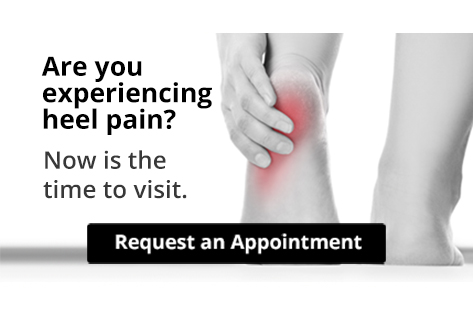Blog
A Lack of Vitamins May Cause Cracked Heels
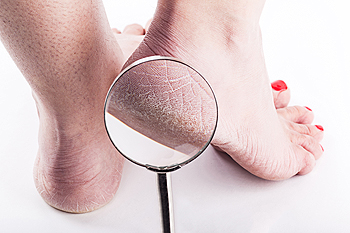
Many people have the foot condition that is known as cracked heels. Various reasons, including vitamin deficiency, can cause this ailment. A lack of vitamin E can affect the skin and cause it to dry. Good sources of this vital nutrient can include sunflower seeds, salmon, avocado, and various oils. Additionally, patients who do not have adequate amounts of vitamin B-3 may develop a condition called pellagra. This can cause the skin to become dry and scaly, affecting the heels. Sources of this vitamin can consist of brown rice, lentils, poultry, and seafood. Existing medical conditions may also lead to developing cracked heels, such as eczema and athlete’s foot. Cracked heels can be prominent among people who frequently walk barefoot and may be prevented when sandals or shoes are worn. If you have cracked heels, it is suggested that you schedule an appointment with a podiatrist who can guide you toward the treatment routine that is correct for you.
Cracked heels are unsightly and can cause further damage to your shoes and feet. If you have any concerns, contact Shaun J. Limon, DPM and Lisa Griffith-Limon, DPM from Limons Foot & Ankle Care. Our doctors can provide the care you need to keep you pain-free and on your feet.
Cracked Heels
Cracked heels appear unappealing and can make it harder for you walk around in sandals. Aside from looking unpleasant, cracked heels can also tear stockings, socks, and wear out your shoes. There are several methods to help restore a cracked heel and prevent further damage.
How Do You Get Them?
Dry skin is the number one culprit in creating cracked heels. Many athletes, walkers, joggers, and even swimmers suffer from cracked heels. Age and skin oil production play a role to getting cracked heels as well.
Promote Healing
Over the counter medicines can help, especially for those that need instant relief or who suffer from chronic dry feet.
Wear Socks – Wearing socks with medicated creams helps lock in moisture.
Moisturizers – Applying both day and night will help alleviate dryness which causes cracking.
Pumice Stones – These exfoliate and remove dead skin, which allows for smoother moisturizer application and better absorption into the skin.
Change in Diet
Eating healthy with a well-balanced diet will give the skin a fresh and radiant look. Your body responds to the kinds of food you ingest. Omega-3 fatty acids and zinc supplements can also revitalize skin tissue.
Most importantly, seek professional help if unsure how to proceed in treating cracked heels. A podiatrist will help you with any questions or information needed.
If you have any questions, please feel free to contact our office located in Lakewood Ranch, FL . We offer the newest diagnostic and treatment technologies for all your foot care needs.
Heel Pain Can Be Treated!
How to Care for Foot Wounds

Having a wound on the foot often requires immediate care. Many diabetic patients are concerned with this, and methods may be implemented that may help to avoid foot wounds. People who are diabetic may have neuropathy, which is the inability to feel existing cuts and wounds on the feet. For this reason, an unattended wound on the foot can lead to serious complications. Proper foot wound care begins with cleaning the wound, applying an antiseptic, and placing an appropriate covering over it, which is known as a dressing. If the wound is severe, it may be necessary to avoid putting weight on the affected foot. Many patients choose to use crutches or wear a protective boot for mobility. If you have developed a wound on your foot, it is strongly suggested that you are under the care of a podiatrist who can effectively treat foot wounds.
Wound care is an important part in dealing with diabetes. If you have diabetes and a foot wound or would like more information about wound care for diabetics, consult with Shaun J. Limon, DPM and Lisa Griffith-Limon, DPM from Limons Foot & Ankle Care. Our doctors will assess your condition and provide you with quality foot and ankle treatment.
What Is Wound Care?
Wound care is the practice of taking proper care of a wound. This can range from the smallest to the largest of wounds. While everyone can benefit from proper wound care, it is much more important for diabetics. Diabetics often suffer from poor blood circulation which causes wounds to heal much slower than they would in a non-diabetic.
What Is the Importance of Wound Care?
While it may not seem apparent with small ulcers on the foot, for diabetics, any size ulcer can become infected. Diabetics often also suffer from neuropathy, or nerve loss. This means they might not even feel when they have an ulcer on their foot. If the wound becomes severely infected, amputation may be necessary. Therefore, it is of the upmost importance to properly care for any and all foot wounds.
How to Care for Wounds
The best way to care for foot wounds is to prevent them. For diabetics, this means daily inspections of the feet for any signs of abnormalities or ulcers. It is also recommended to see a podiatrist several times a year for a foot inspection. If you do have an ulcer, run the wound under water to clear dirt from the wound; then apply antibiotic ointment to the wound and cover with a bandage. Bandages should be changed daily and keeping pressure off the wound is smart. It is advised to see a podiatrist, who can keep an eye on it.
If you have any questions, please feel free to contact our office located in Lakewood Ranch, FL . We offer the newest diagnostic and treatment technologies for all your foot care needs.
Advantages of Custom Orthotics

If you regularly suffer from foot pain, it is beneficial to spend some time investigating the best type of insoles, which are also referred to as orthotics, to address the situation. Foot pain can have many causes, so the first order of business is to determine the source of discomfort. Many people with plantar fasciitis, metatarsalgia, bunions, or flat feet are candidates for shoe inserts, which are premade, one-size-fits-all types. Custom orthotics, however, are produced from a mold of your feet and designed to address the specific foot problem you have. While store-bought inserts are less expensive, a custom orthotic is well worth the extra cost. In addition, because the custom orthotic fits your foot perfectly, it also feels comfortable inside your shoe. Finally, a premade orthotic insert may change your gait and do more harm than good. For help with finding the right orthotics for your feet, it is suggested that you make an appointment with a podiatrist for a thorough examination of your foot problem.
If you are having discomfort in your feet and would like to try orthotics, contact Shaun J. Limon, DPM and Lisa Griffith-Limon, DPM from Limons Foot & Ankle Care. Our doctors can provide the care you need to keep you pain-free and on your feet.
What Are Orthotics?
Orthotics are inserts you can place into your shoes to help with a variety of foot problems such as flat feet or foot pain. Orthotics provide relief and comfort for minor foot and heel pain but can’t correct serious biomechanical problems in your feet.
Over-the-Counter Inserts
Orthotics come in a wide variety of over-the-counter inserts that are used to treat foot pain, heel pain, and minor problems. For example, arch supports can be inserted into your shoes to help correct overarched or flat feet, while gel insoles are often used because they provide comfort and relief from foot and heel pain by alleviating pressure.
Prescription Orthotics
If over-the-counter inserts don’t work for you or if you have a more severe foot concern, it is possible to have your podiatrist prescribe custom orthotics. These high-quality inserts are designed to treat problems such as abnormal motion, plantar fasciitis, and severe forms of heel pain. They can even be used to help patients suffering from diabetes by treating foot ulcers and painful calluses and are usually molded to your feet individually, which allows them to provide full support and comfort.
If you are experiencing minor to severe foot or heel pain, it’s recommended to speak with your podiatrist about the possibilities of using orthotics. A podiatrist can determine which type of orthotic is right for you and allow you to take the first steps towards being pain-free.
If you have any questions please contact our offices located in Bradenton and Lakewood Ranch, FL . We offer the newest diagnostic and treatment technologies for all your foot and ankle needs.
Reminder: When Was the Last Time...?
Common Symptoms of Poor Circulation
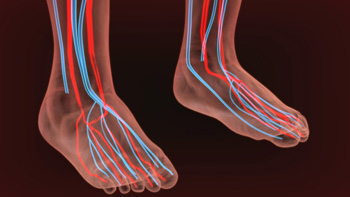
Patients who have poor circulation may notice their feet are cold, regardless of the temperature in the room. Additionally, having swollen feet may also be a sign of poor circulation. This may be a result of reduced blood flow, possibly causing the kidneys to function improperly. People who are constantly tired may have poor circulation, which can come from a lack of oxygen and nutrients. A weakened immune system and poor circulation may be linked together, possibly improving with regular exercise. Poor circulation can cause the scalp to become dry, and may lead to a gradual loss of hair. Patients who are afflicted with this condition may notice their nails are affected, as they can become fragile and break easier. If you have the above symptoms and your feet are affected, it is suggested that you confer with a podiatrist who can properly diagnose and treat poor circulation.
Poor circulation is a serious condition and needs immediate medical attention. If you have any concerns with poor circulation in your feet contact Shaun J. Limon, DPM and Lisa Griffith-Limon, DPM of Limons Foot & Ankle Care. Our doctors will treat your foot and ankle needs.
Poor Circulation in the Feet
Poor blood circulation in the feet and legs is can be caused by peripheral artery disease (PAD), which is the result of a buildup of plaque in the arteries.
Plaque buildup or atherosclerosis results from excess calcium and cholesterol in the bloodstream. This can restrict the amount of blood which can flow through the arteries. Poor blood circulation in the feet and legs are sometimes caused by inflammation in the blood vessels, known as vasculitis.
Causes
Lack of oxygen and oxygen from poor blood circulation restricts muscle growth and development. It can also cause:
- Muscle pain, stiffness, or weakness
- Numbness or cramping in the legs
- Skin discoloration
- Slower nail & hair growth
- Erectile dysfunction
Those who have diabetes or smoke are at greatest risk for poor circulation, as are those who are over 50. If you have poor circulation in the feet and legs it may be caused by PAD and is important to make changes to your lifestyle in order to reduce risk of getting a heart attack or stroke. Exercise and maintaining a healthy lifestyle will dramatically improve conditions.
As always, see a podiatrist as he or she will assist in finding a regimen that suits you. A podiatrist can also prescribe you any needed medication.
If you have any questions please feel free to contact our offices located in Bradenton and Lakewood Ranch, FL . We offer the newest diagnostic and treatment technologies for all your foot and ankle needs.
A Tell-Tale Symptom of Flat Feet

Flat feet are a common foot ailment that can be easy to observe. While standing up, does the entire foot lie flat on the floor? Most babies are born with flat feet, and the arch generally develops by the teenage years. This may not be the case for some adults, as genetics may contribute to having flat feet. Additionally, if a foot injury has occurred, flat feet may be the result. Many people do not experience pain with flat feet and can complete daily activities. Conversely, flat feet may cause pain and discomfort, and measures can be implemented to help reduce existing pain. These can include performing specific stretches that are tailored for patients with flat feet, in addition to wearing custom-made orthotics. If you have flat feet, it is strongly suggested that you are under the care of a podiatrist who can monitor your balance and general foot health.
Flatfoot is a condition many people suffer from. If you have flat feet, contact Shaun J. Limon, DPM and Lisa Griffith-Limon, DPM from Limons Foot & Ankle Care. Our doctors will treat your foot and ankle needs.
What Are Flat Feet?
Flatfoot is a condition in which the arch of the foot is depressed and the sole of the foot is almost completely in contact with the ground. About 20-30% of the population generally has flat feet because their arches never formed during growth.
Conditions & Problems:
Having flat feet makes it difficult to run or walk because of the stress placed on the ankles.
Alignment – The general alignment of your legs can be disrupted, because the ankles move inward which can cause major discomfort.
Knees – If you have complications with your knees, flat feet can be a contributor to arthritis in that area.
Symptoms
- Pain around the heel or arch area
- Trouble standing on the tip toe
- Swelling around the inside of the ankle
- Flat look to one or both feet
- Having your shoes feel uneven when worn
Treatment
If you are experiencing pain and stress on the foot you may weaken the posterior tibial tendon, which runs around the inside of the ankle.
If you have any questions please feel free to contact our offices located in Bradenton and Lakewood Ranch, FL . We offer the newest diagnostic and treatment technologies for all your foot and ankle needs.
Why Live with Pain and Numbness in Your Feet?
Pregnancy Causes Changes to the Feet

The entire body changes during pregnancy, and the feet are no exception. Many women notice their feet have grown, which may be attributed to pregnancy hormones the body produces. As the pregnancy progresses, the feet may become swollen, and the arches may flatten as additional weight is gained. Relief may be found when shoes that are worn have a low heel and healthy foods are consumed. It is helpful to refrain from eating salty foods, and frequently elevating the feet may reduce the swelling. Swollen feet may also be a symptom of poor circulation, which may happen from the body recirculating extra fluid that is needed by the growing fetus. It is beneficial to stay as active as possible, drink plenty of water daily, and sleep on the left side. If you have additional questions about how pregnancy can affect the feet, it is suggested that you consult with a podiatrist who can address any concerns you may have.
Pregnant women with swollen feet can be treated with a variety of different methods that are readily available. For more information about other cures for swollen feet during pregnancy, consult with Shaun J. Limon, DPM and Lisa Griffith-Limon, DPM from Limons Foot & Ankle Care. Our doctors will attend to all of your foot and ankle needs.
What Foot Problems Can Arise During Pregnancy?
One problem that can occur is overpronation, which occurs when the arch of the foot flattens and tends to roll inward. This can cause pain and discomfort in your heels while you’re walking or even just standing up, trying to support your baby.
Another problem is edema, or swelling in the extremities. This often affects the feet during pregnancy but tends to occur in the later stages.
How Can I Keep My Feet Healthy During Pregnancy?
- Wearing orthotics can provide extra support for the feet and help distribute weight evenly
- Minimize the amount of time spent walking barefoot
- Wear shoes with good arch support
- Wear shoes that allow for good circulation to the feet
- Elevate feet if you experience swelling
- Massage your feet
- Get regular, light exercise, such as walking, to promote blood circulation to the feet
If you have any questions please feel free to contact our offices located in Bradenton and Lakewood Ranch, FL . We offer the newest diagnostic and treatment technologies for all your foot and ankle needs.
Reasons for Foot Cramps

Anyone who has experienced a foot cramp is familiar with the discomfort it can cause. It may happen as a result of being dehydrated, or from having low potassium levels. The latter condition can be referred to as hypokalemia and may be accompanied by fatigue and weakness. Wearing tight shoes may also cause foot cramps, in addition to having specific types of nerve damage. A foot cramp is a sudden contraction of a muscle, and it can happen during the day. It may also wake a patient up from sleeping, and pointing and stretching the foot may bring temporary relief. People who frequently exercise may find they occasionally get foot cramps, possibly as a result of having overworked muscles. Existing medications may cause foot cramps. These can include asthma, blood pressure, and statin drugs, in addition to medicine for Alzheimer’s disease. If you are experiencing foot cramps, it is suggested that you consult with a podiatrist who can determine what the cause is, and offer correct treatment options.
Foot Pain
Foot pain can be extremely painful and debilitating. If you have a foot pain, consult with Shaun J. Limon, DPM and Lisa Griffith-Limon, DPM from Limons Foot & Ankle Care. Our doctors will assess your condition and provide you with quality foot and ankle treatment.
Causes
Foot pain is a very broad condition that could be caused by one or more ailments. The most common include:
- Bunions
- Hammertoes
- Plantar Fasciitis
- Bone Spurs
- Corns
- Tarsal Tunnel Syndrome
- Ingrown Toenails
- Arthritis (such as Gout, Rheumatoid, and Osteoarthritis)
- Flat Feet
- Injury (from stress fractures, broken toe, foot, ankle, Achilles tendon ruptures, and sprains)
- And more
Diagnosis
To figure out the cause of foot pain, podiatrists utilize several different methods. This can range from simple visual inspections and sensation tests to X-rays and MRI scans. Prior medical history, family medical history, and any recent physical traumatic events will all be taken into consideration for a proper diagnosis.
Treatment
Treatment depends upon the cause of the foot pain. Whether it is resting, staying off the foot, or having surgery; podiatrists have a number of treatment options available for foot pain.
If you have any questions, please feel free to contact our offices located in Bradenton and Lakewood Ranch, FL . We offer the newest diagnostic and treatment technologies for all your foot care needs.
More...
Plantar Warts Can Be Treated!
Health Benefits of Walking
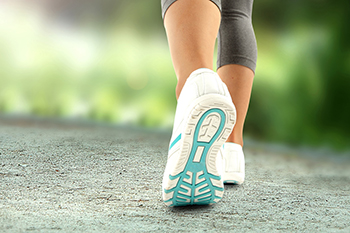
Walking is something nearly everyone learns to do as a child. As an adult, however, it is easy to ignore walking as a beneficial type of exercise. In fact, walking is an aerobic and cardio exercise that can increase strength, improve cardiovascular health, and even help you lose weight. Experts identify five types of walking that can lower blood pressure, increase energy, improve blood flow, and just plain make you feel better. Included are race or Olympic walking, brisk walking, Nordic or pole walking, speed walking, and Chi walking. Each of these walking styles differs somewhat in distance, speed, and other considerations, such as using poles. Probably the most accessible for someone starting out is brisk walking, mainly because there are few rules involved and it is easy to do with a friend. Brisk walking is done at a conversational pace and should not cause shortness of breath. Activating the core muscles is essential to proper walking in any form and also helps to reduce the chance of injury to other body parts. For more information about the benefits of walking as an exercise, it is suggested that you consult a podiatrist.
Exercising your feet regularly with the proper foot wear is a great way to prevent injuries and build strength. If you have any concerns about your feet, contact Shaun J. Limon, DPM and Lisa Griffith-Limon, DPM from Limons Foot & Ankle Care. Our doctors can provide the care you need to keep you pain-free and on your feet.
Exercise for Your Feet
Exercise for your feet can help you gain strength, mobility and flexibility in your feet. They say that strengthening your feet can be just as rewarding as strengthening another part of the body. Your feet are very important, and we often forget about them in our daily tasks. But it is because of our feet that are we able to get going and do what we need to. For those of us fortunate enough to not have any foot problems, it is an important gesture to take care of them to ensure good health in the long run.
Some foot health exercises can include ankle pumps, tip-toeing, toe rises, lifting off the floor doing reps and sets, and flexing the toes. It is best to speak with Our doctors to determine an appropriate regimen for your needs. Everyone’s needs and bodies are different, and the activities required to maintain strength in the feet vary from individual to individual.
Once you get into a routine of doing regular exercise, you may notice a difference in your feet and how strong they may become.
If you have any questions please feel free to contact our offices located in Bradenton and Lakewood Ranch, FL . We offer the newest diagnostic and treatment technologies for all your foot and ankle needs.
The Perils of Wearing Flip-Flops
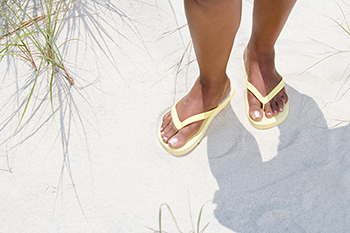
Flip-flops can have long-term negative consequences on the feet because of their lack of support. They put strain on joints and allow the foot to collapse. This affects the gait and posture and can put unnecessary pressure on the foot and rest of the body. This type of footwear contributes to our feet pronating for longer periods of time than is normal and can change the biomechanics of the feet. Foot deformities such as bunions and hammertoes, and painful conditions associated with overpronation, like arch and heel pain and overall body pain can result. Flip-flops should not be worn for prolonged lengths of time. It is okay to wear them for activities that are short-lived and not strenuous, like at the beach or around pools. If you would like to discuss wearing flip-flops or better alternatives, it is suggested that you consult with a podiatrist who can provide you with more information.
Flip-flops are not always the best choice of footwear. If you have any concerns about your feet or ankles, contact Shaun J. Limon, DPM and Lisa Griffith-Limon, DPM from Limons Foot & Ankle Care. Our doctors will assist you with all of your foot and ankle needs.
Flip-Flops and Feet
When the weather starts warming up, people enjoy wearing flip-flops. Flip-flops are comfortable, stylish, and easy to slip on and off; they're perfect for any summer beach goer. However, these shoes can cause harm to the feet.
How Can Flip-Flops Affect Me Long-Term?
- Ankle problems
- Hip problems
- Lower back problems
- Pain in the balls of the feet
- Problems with foot arches
- Changes in the way you walk
Are There Injuries Associated with Flip-Flops?
Yes. Since flip-flops are relatively weak and do not provide the same amount of support as sneakers, people who wear flip-flops regularly are more susceptible to injuries. On top of that, the open nature of the shoe makes your feet more prone to other problems, such as cuts and even infections. Common injuries and ailments include:
- Sprained ankles
- Blisters
- Infections
- Cuts and Scrapes
I like Wearing Flip-Flops. Are There Safe Alternatives?
When buying flip-flops, try to find ones that have sturdy soles and that are made of high-quality materials that will support for your feet. These flip-flops will cost more but will also last longer as a result.
If you have any questions please feel free to contact our offices located in Bradenton and Lakewood Ranch, FL . We offer the newest diagnostic and treatment technologies for all your foot and ankle needs.
